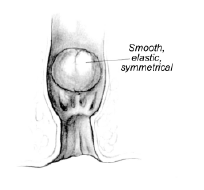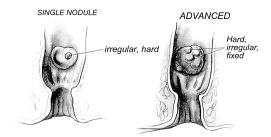Common Anorectal Conditions
Anorectal fistula:
 An anorectal fistula is an inflammatory tract or tube that opens at one end into the anus or rectum and at the other end onto the skin surface (as shown here) or into another vscus. An abscess usually antedates such a fistula. Look for the fistulous opening or openings anywhere in the skin around the anus.
An anorectal fistula is an inflammatory tract or tube that opens at one end into the anus or rectum and at the other end onto the skin surface (as shown here) or into another vscus. An abscess usually antedates such a fistula. Look for the fistulous opening or openings anywhere in the skin around the anus.
Anal fissure :
 An anal fissure is a very painful oval ulceration of the anal canal, most commonly found in the midline posteriorly, less commonly in the midline anteriorly. Its long axis lies longitudinally. Inspection may reveal a "sentinel" skin tag just below it, and gentle separation of the anal margins may reveal the lower edge of the fissure. The sphincter is spastic; the examination painful. Local anaesthesia may be required.
An anal fissure is a very painful oval ulceration of the anal canal, most commonly found in the midline posteriorly, less commonly in the midline anteriorly. Its long axis lies longitudinally. Inspection may reveal a "sentinel" skin tag just below it, and gentle separation of the anal margins may reveal the lower edge of the fissure. The sphincter is spastic; the examination painful. Local anaesthesia may be required.
External Hemorrhoid : Hemorrhoids are varicose veins. External hemorrhoids originate below the anorectal line and are covered by anal skin. When uncomplicated, they may not be visible at rest, but a thrombosed hemorrhoid presents as a painful, bluish, shiny, ovoid mass at the anal margin. Flabby or fibrotic skin tags may mark the location of previously thrombosed or inflamed hemorrhoids.
Hemorrhoids are varicose veins. External hemorrhoids originate below the anorectal line and are covered by anal skin. When uncomplicated, they may not be visible at rest, but a thrombosed hemorrhoid presents as a painful, bluish, shiny, ovoid mass at the anal margin. Flabby or fibrotic skin tags may mark the location of previously thrombosed or inflamed hemorrhoids.
Internal Hemorrhoid :
Prolapse of the Rectum
 On straining for a bowel movement the rectal mucosa, with or without its muscular wall, may prolapse through the anus, presenting as a doughnut or rosette of red mucosa. A prolapse involving only mucosa is shown here. When the entire bowel wall is involved the prolapse is larger, and circular rather than radiating folds are seen.
On straining for a bowel movement the rectal mucosa, with or without its muscular wall, may prolapse through the anus, presenting as a doughnut or rosette of red mucosa. A prolapse involving only mucosa is shown here. When the entire bowel wall is involved the prolapse is larger, and circular rather than radiating folds are seen.
Polyps of the Rectum :
 Polyps of the rectum are fairly common. Varying considerably in size and number, they can develop on a stalk (pendunculated)) or lie close to the mucosal surface (sessile). They are soft and may be difficult or impossible to feel even when in reach of the examining finger. Proctoscopy is isually required for diagnosis, as is biopsy for the differentiation of benign from malignant lesions.
Polyps of the rectum are fairly common. Varying considerably in size and number, they can develop on a stalk (pendunculated)) or lie close to the mucosal surface (sessile). They are soft and may be difficult or impossible to feel even when in reach of the examining finger. Proctoscopy is isually required for diagnosis, as is biopsy for the differentiation of benign from malignant lesions.
Carcinoma of the Rectum:

Asymptomatic carcinom of the reectum makes routine rectal examination mandatory for virtually all adults. As noted above, polypoid masses may be malignant. Another common form of presentation is the firm, nodular, rolled edge of an ulcerated malignancy.
Peritoneal metastases:
 Widespread peritoneal metastases from any source may develop in the are of the peritoneal reflection anterior to the rectum. A firm to hard nodular rectal "shelf" may be just palpable with the tip of the examining finger.
Widespread peritoneal metastases from any source may develop in the are of the peritoneal reflection anterior to the rectum. A firm to hard nodular rectal "shelf" may be just palpable with the tip of the examining finger.
The Normal prostate gland : As palpated through the anterior rectal wall, the normal prostate is a rounded, heart-shaped structure about 2.5 cm in length, projecting less than 1.0 cm into the rectal lumen. The median sulcus can be felt between the two lateral lobes. Only the posterior surface of the prostate is palpable. Anterior lesions, including those that may obstruct the urthra, may not be detectable by physical examination.
As palpated through the anterior rectal wall, the normal prostate is a rounded, heart-shaped structure about 2.5 cm in length, projecting less than 1.0 cm into the rectal lumen. The median sulcus can be felt between the two lateral lobes. Only the posterior surface of the prostate is palpable. Anterior lesions, including those that may obstruct the urthra, may not be detectable by physical examination.
Benign Prostatic Hypertrophy :

A very common condition in men over 50 years of age, benign prostatic hypertrophy presents as a firm, smooth, symmetrical, and slightly elastic enlargement of the gland. It may bulge more than a centimeter into the rectal lumen. The hypertrophied tissue tends to obliterate the median sulcus.
Carcinoma of the Prostate: A hard, irregular nodule, producing asymmetry of the gland and a variation in its consistency, is especially suggestive of carcinoma. Prostatic stones and chronic inflammation can produce similar findings, and differential diagnosis often depends upon biopsy. Later in its course the carcinoma grows in size, obliterates the median sulcus, and may extend beyond the confines of the gland, producing a fixed, hard, irregular mass.
A hard, irregular nodule, producing asymmetry of the gland and a variation in its consistency, is especially suggestive of carcinoma. Prostatic stones and chronic inflammation can produce similar findings, and differential diagnosis often depends upon biopsy. Later in its course the carcinoma grows in size, obliterates the median sulcus, and may extend beyond the confines of the gland, producing a fixed, hard, irregular mass.
Prostatitis :
 The acutely inflamed prostategland is swollen, tender, and often somewheat asymmetrical.
The acutely inflamed prostategland is swollen, tender, and often somewheat asymmetrical.
The gland of chronic prostatitis is variable; it may (1) feel normal, (2) be somewhat enlarged, tender, and boggy, or (3) contain scattered firm areas of fibrosis.





Comments
good but need details